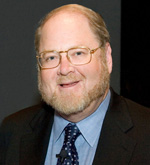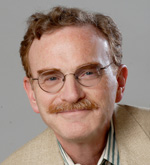October 21, 2013 - By Bruce Goldman

James Rothman

Randy Schekman
In addition to Thomas Südhof, MD, professor of molecular and cellular physiology, the two other recipients of the 2013 Nobel Prize in Physiology or Medicine have strong connections to the Stanford School of Medicine.
James Rothman, PhD, of Yale University, spent a critical and prolific decade in Stanford's Department of Biochemistry between 1978 and 1988. And Randy Schekman, PhD, of UC-Berkeley, earned his PhD in that department in 1975.
The three scientists' Nobel Prize was awarded for their research on how proteins and other substances are sequestered within tiny balloon-like vesicles and chauffeured from one compartment to another within a cell until they reach their final intercellular destinations or are secreted.
"That's exactly my line of research," said Suzanne Pfeffer, PhD, professor and chair of biochemistry and the Emma Pfeiffer Merner Professor of Medical Sciences. "Although it's a little hard to explain, it is broadly relevant to human health and disease. Almost any kind of disease you can think of involves moving things around in cells."
Pfeffer characterized Südhof as a "wonderful" scientist. But she's known both Rothman and Schekman for much longer.
Schekman was a Stanford biochemistry graduate student under the direction of the department's founder, the late Arthur Kornberg, PhD. After earning a doctorate at Stanford, Schekman joined UC-Berkeley's faculty in 1976. Although Schekman's Nobel-related research began with genetics, it was later followed by work that, Pfeffer said, was directly influenced by Kornberg's pioneering idea of "reconstitution" — the breaking down of complex intracellular processes into individual steps in cell-free extracts. (Unraveling the mysteries of DNA synthesis in this manner won Kornberg the Nobel Prize in Physiology or Medicine in 1959).
In 1984 and 1985, Pfeffer was a postdoctoral scholar in Rothman's laboratory. At the time, Rothman was a professor of biochemistry at Stanford and had already embarked on the work that would lead to his Nobel, she said. "What Jim wanted to do was to devise a way to break open cells and study the process by which they shuttle materials between different compartments, and recreate this important process in the test tube," Pfeffer recalled. He succeeded in doing that, for the first time ever, just before Pfeffer arrived at Stanford.
"My years at Stanford loom extremely large, even today, many years later," Rothman said in a telephone interview. "I'm not sure I could have done what I did at many other places."
Rothman said he came to Stanford's biochemistry department largely because of Kornberg. "Arthur was one of the great biochemists of the 20th century," he said. "How can you help but be influenced by a giant like that? When I was offered an opportunity to come to Stanford, I actually left Harvard Medical School specifically to have the opportunity to have a laboratory next to his."
Kornberg's revolutionary, methodological approach was a major influence on Rothman's work. So was Kornberg's "megawatt" presence, he said. "Once, I was in one of those periods of failure, and I was being doubted by my colleagues. 'Jim,' Arthur told me, 'just work on something important that everybody else thinks can't work and that you think will, because you think you know how to do it.'"
Robert Lehman, PhD, the William M. Hume Professor Emeritus in the School of Medicine, was department chair during Rothman's tenure. "All of us were very much impressed with his intelligence," said Lehman. "It was immediately obvious that he was a brilliant young man and would do important work. We promptly offered him a job. He wanted to study intracellular trafficking of proteins in a cell-free extract. Few people thought that could be done. He eventually proved that it could."
Writer Louis Bergeron contributed to this report.
About Stanford Medicine
Stanford Medicine is an integrated academic health system comprising the Stanford School of Medicine and adult and pediatric health care delivery systems. Together, they harness the full potential of biomedicine through collaborative research, education and clinical care for patients. For more information, please visit med.stanford.edu.